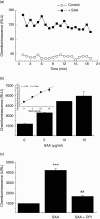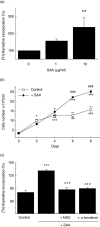Serum amyloid A induces reactive oxygen species (ROS) production and proliferation of fibroblast
- PMID: 21175596
- PMCID: PMC3048620
- DOI: 10.1111/j.1365-2249.2010.04300.x
Serum amyloid A induces reactive oxygen species (ROS) production and proliferation of fibroblast
Abstract
Serum amyloid A (SAA) levels are elevated highly in acute phase response and elevated slightly and persistently in chronic diseases such as rheumatoid arthritis and diabetes. Given that fibroblasts exert profound effects on progression of inflammatory chronic diseases, the aim of this study was to investigate the response of fibroblasts to SAA. A dose-dependent increase in O(2) (-) levels was observed by treatment of fibroblasts with SAA (r = 0·99 and P ≤ 0·001). In addition, the expression of p47-phox was up-regulated by SAA (P < 0·001) and diphenyliodonium (DPI), a nicotinamide adenine dinucleotide phosphate (NADPH) oxidase inhibitor, reduced the release of O(2) (-) by 50%. Also, SAA raised fibroblast proliferation (P < 0·001) and this effect was completely abolished by the addition of anti-oxidants (P < 0·001). These findings support the notion that, in chronic inflammatory sites, SAA activated fibroblast proliferation and ROS production.
© 2010 The Authors. Clinical and Experimental Immunology © 2010 British Society for Immunology.
Figures


Similar articles
-
Volume-sensitive NADPH oxidase activity and taurine efflux in NIH3T3 mouse fibroblasts.Am J Physiol Cell Physiol. 2008 Jun;294(6):C1552-65. doi: 10.1152/ajpcell.00571.2007. Epub 2008 Apr 16. Am J Physiol Cell Physiol. 2008. PMID: 18417717
-
Oxidative stress in scleroderma: maintenance of scleroderma fibroblast phenotype by the constitutive up-regulation of reactive oxygen species generation through the NADPH oxidase complex pathway.Arthritis Rheum. 2001 Nov;44(11):2653-64. doi: 10.1002/1529-0131(200111)44:11<2653::aid-art445>3.0.co;2-1. Arthritis Rheum. 2001. PMID: 11710721
-
Activation and inactivation of the volume-sensitive taurine leak pathway in NIH3T3 fibroblasts and Ehrlich Lettre ascites cells.Am J Physiol Cell Physiol. 2007 Jul;293(1):C390-400. doi: 10.1152/ajpcell.00104.2007. Epub 2007 May 30. Am J Physiol Cell Physiol. 2007. PMID: 17537804
-
Diphenyleneiodonium chloride, an inhibitor of reduced nicotinamide adenine dinucleotide phosphate oxidase, suppresses light-dependent induction of clock and DNA repair genes in zebrafish.Biol Pharm Bull. 2011;34(8):1343-7. doi: 10.1248/bpb.34.1343. Biol Pharm Bull. 2011. PMID: 21804230
-
Effect of atrial natriuretic peptide on reactive oxygen species-induced by hydrogen peroxide in THP-1 monocytes: role in cell growth, migration and cytokine release.Peptides. 2013 Dec;50:100-8. doi: 10.1016/j.peptides.2013.09.002. Epub 2013 Oct 11. Peptides. 2013. PMID: 24120989
Cited by
-
Lung epithelial cells are essential effectors of inducible resistance to pneumonia.Mucosal Immunol. 2014 Jan;7(1):78-88. doi: 10.1038/mi.2013.26. Epub 2013 May 1. Mucosal Immunol. 2014. PMID: 23632328 Free PMC article.
-
Serum amyloid A links endotoxaemia to weight gain and insulin resistance in mice.Diabetologia. 2016 Aug;59(8):1760-8. doi: 10.1007/s00125-016-3970-z. Epub 2016 Apr 28. Diabetologia. 2016. PMID: 27126803
-
Acute Inflammation Is a Predisposing Factor for Weight Gain and Insulin Resistance.Pharmaceutics. 2022 Mar 11;14(3):623. doi: 10.3390/pharmaceutics14030623. Pharmaceutics. 2022. PMID: 35335996 Free PMC article.
-
Serum amyloid A induces interleukin-1β secretion from keratinocytes via the NACHT, LRR and PYD domains-containing protein 3 inflammasome.Clin Exp Immunol. 2015 Feb;179(2):344-53. doi: 10.1111/cei.12458. Clin Exp Immunol. 2015. PMID: 25231464 Free PMC article. Clinical Trial.
-
Novel treatment of neuroinflammation against low back pain by soluble fullerol nanoparticles.Spine (Phila Pa 1976). 2013 Aug 1;38(17):1443-51. doi: 10.1097/BRS.0b013e31828fc6b7. Spine (Phila Pa 1976). 2013. PMID: 23466506 Free PMC article.
References
-
- Furlaneto CJ, Campa A. A novel function of serum amyloid A: a potent stimulus for the release of tumor necrosis factor-alpha, interleukin-1beta, and interleukin-8 by human blood neutrophil. Biochem Biophys Res Commun. 2000;268:405–8. - PubMed
-
- Hatanaka E, Furlaneto CJ, Ribeiro FP, Souza GM, Campa A. Serum amyloid A-induced mRNA expression and release of tumor necrosis factor-alpha (TNF-alpha) in human neutrophils. Immunol Lett. 2004;91:33–7. - PubMed
-
- Sandri S, Hatanaka E, Franco AG, Pedrosa AM, Monteiro HP Campa A. Serum amyloid A induces CCL20 secretion in mononuclear cells through MAPK (p38 and ERK1/2) signaling pathways. Immunol Lett. 2008;121:22–6. - PubMed
-
- Sandri S, Rodriguez D, Gomes E, Monteiro HP, Russo M, Campa A. Is serum amyloid A an endogenous TLR4 agonist? J Leukoc Biol. 2008;83:1174–80. - PubMed
Publication types
MeSH terms
Substances
LinkOut - more resources
Full Text Sources

